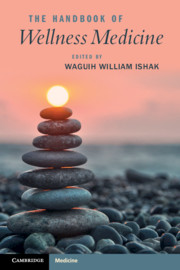Book contents
- The Handbook of Wellness Medicine
- The Handbook of Wellness Medicine
- Copyright page
- Dedication
- Contents
- Contributors
- Part I Approach to Wellness
- Part II From Illness to Wellness by Organ Systems/Disorders
- Part III Special Populations and Special Topics
- Chapter 14 Wellness Interventions in Patients Living with Chronic Medical Conditions
- Chapter 15 Wellness in Older Individuals
- Chapter 16 Wellness in Children and Adolescents
- Chapter 17 Wellness in Pain Disorders
- Chapter 18 Wellness in Cancer and Neoplastic Diseases
- Chapter 19 Wellness in Terminal Illness
- Chapter 20 Wellness Interventions in the Workplace
- Chapter 21 Wellness Interventions for Physicians and Healthcare Professionals
- Part IV Wellness Interventions
- Part V Wellness through Optimization of Work, Love, and Play
- Book part
- Index
- References
Chapter 15 - Wellness in Older Individuals
from Part III - Special Populations and Special Topics
Published online by Cambridge University Press: 18 September 2020
- The Handbook of Wellness Medicine
- The Handbook of Wellness Medicine
- Copyright page
- Dedication
- Contents
- Contributors
- Part I Approach to Wellness
- Part II From Illness to Wellness by Organ Systems/Disorders
- Part III Special Populations and Special Topics
- Chapter 14 Wellness Interventions in Patients Living with Chronic Medical Conditions
- Chapter 15 Wellness in Older Individuals
- Chapter 16 Wellness in Children and Adolescents
- Chapter 17 Wellness in Pain Disorders
- Chapter 18 Wellness in Cancer and Neoplastic Diseases
- Chapter 19 Wellness in Terminal Illness
- Chapter 20 Wellness Interventions in the Workplace
- Chapter 21 Wellness Interventions for Physicians and Healthcare Professionals
- Part IV Wellness Interventions
- Part V Wellness through Optimization of Work, Love, and Play
- Book part
- Index
- References
Summary
Given the increase in life expectancy and increased number of older people, larger numbers of older people will develop more comorbidities and functional impairments. Wellness in older individuals includes the continuum of primary and secondary prevention toward healthy aging, to both help prevent and screen for these comorbidities and functional impairments. This chapter reviews primary and secondary prevention, with a focus on healthcare maintenance, social isolation, physical activity in older adults, and nutrition. The first section reviews United States Preventive Services Task Force (USPSTF), Centers for Disease Control and Prevention (CDC), Advisory Committee on Immunization Practices (ACIP), and American Cancer Society (ACS) recommendations for immunizations and appropriate screening tools for age, as well as comprehensive geriatric assessment. Regarding physical activity in older adults, there is an extensive review of evidence-based recommendations for patients, including guidelines and tools providers may use. The international epidemic of social isolation is reviewed, along with the importance of screening for it and its associated morbidity and mortality. Finally, screening, risk factors, and interventions for nutritional problems in older persons are reviewed.
- Type
- Chapter
- Information
- The Handbook of Wellness Medicine , pp. 188 - 198Publisher: Cambridge University PressPrint publication year: 2020



